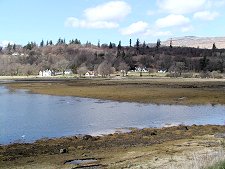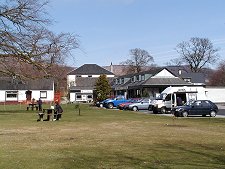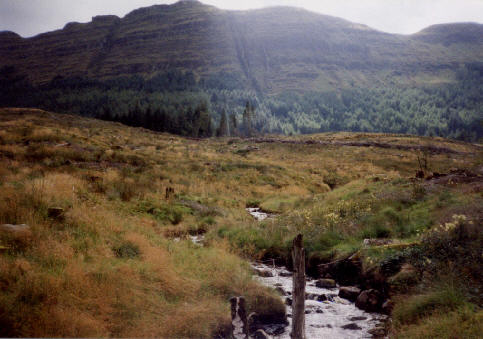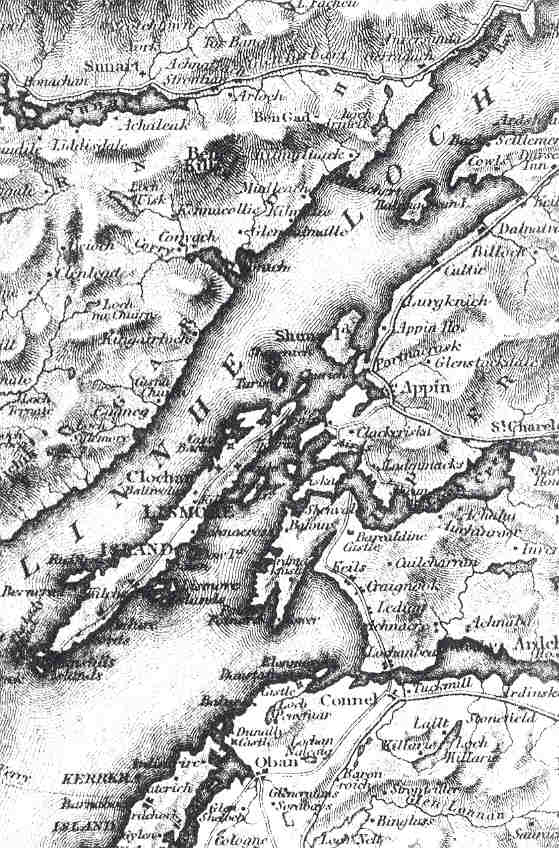Strontian
Argyllshire, Scotland

Strontian village

The Strontian village center
Strontian
Argyllshire, Scotland

Strontian village

The Strontian village center
From www.undiscoveredscotland.co.uk: "Strontian appears as a white-painted oasis on an inlet in the sea-loch, Loch Sunart. The main part of the village is fairly modern in appearance and is grouped around an attractive green. A northern arm, Scotstown, stretches north along the valley of the Strontian River. The name derives from the Gaelic for "Point of the Fairies".
Strontian has a rare claim to fame. In the 18th Century lead mines in the area were worked by French prisoners of war, ironically enough to provide shot to assist the British war effort against France. What also turned up was the first signs of a new element, later named Strontium after the village."
A letter from a Cameron cousin tells of the lost village of Inniemore in Strontian: "Strontian is on the Morven peninsula, at the eastern end of Loch Sunart...One other reason for visiting the area was to see the lost village of Inniemore (An t-Aoineadh Mor in Gaelic). During 1994, while an area of trees on the Morvern peninsula were being felled, they discovered the remains of dwelling houses, dating from the early 19th century. A local historian, Ian Thornber, identified them as belonging to a village called Inniemore. The village was emptied during the clearances to make way for sheep rearing. The villages was populated by Camerons, and had links going back to Bonnie Prince Charles and the rebellion. The process of eviction was later chronicled in a Victorian magazine, and made much of England aware of the clearances. In 1994 the discovery was publicised in one of our national newspapers, the Guardian, and raised the idea of turning the site into a heritage site: "In 1824 the Cameron settlement at Inniemore in Morvern, a remote peninsula on the wild west coast of Scotland, was cleared to make way for sheep. The discovery was made by Iain Thornber, local historian, magistrate, and estate factor. Armed with old men's tales of a village buried by the 60-year old Fuinary plantation, and one of the most harrowing accounts of a mass eviction ever recorded, he finally located Inniemore this spring in the wake of a tree felling operation on the north-facing slopes of 1,806-foot Sithean na Raiplach. "It is one of the biggest and best preserved of a cleared village on the whole west coast", declared Mr. Thornber. There was once a Inniemore shinty team, and a tobacconist's shop. Jean Cameron, who led an Inniemore unit to join the Jacobite uprising in 1745, and who probably lived in the most easterly ruin, was rumored to have been Bonnie Prince Charlie's mistress...Mary Cameron's eyewitness account of Inniemore's dissolution reached a rapt British readership via the magazine "Good Words", and had an enormouse impact on developing unease at what had been done in the name of progress. "The hissing of the fire on the flag of the hearth as they were drowning it reach my heart", she said, "The aged woman, the mother of my husband was then alive, weak and lame. James carried her on his back, in a creel." On the ridge of Sithean na Raiplach, refugees destined for Glasgow and the colonies turned for a last look. "The houses were already stripped. The bleat of the big sheep was on the mountain." Inniemore, the village of the Cameron highlanders, was cleared to make way for sheep. Later the sheep were replaced with forestry.
From forestry.gov.uk: "When tree felling began in this forest in 1994, foresters revealed the township of An t-Aoineadh Mor, cleared of its people in the early 1800's to be replaced by sheep. By the 1940's, the sheep had also gone, to be followed by trees, the new cash crop at that time. These have been harvested with great care and Forest Enterprise now protects the ruins as an important reminder of Morvern's heritage. A small car park is set in a birchwood with picnic tables and an imformation panel. Walking trails head off to the historic village from here."
There is a song about the lost village of Inniemore.

A map of the area around Strontian (at the top of the map, just east of Sunart)
